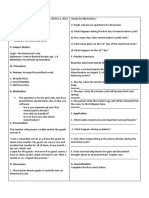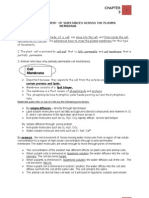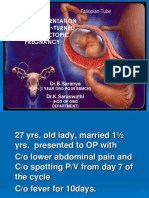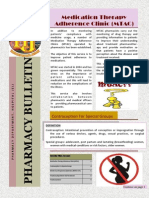Module Questions
Uploaded by
zulkarnainModule Questions
Uploaded by
zulkarnainCHAPTER 12: REPRODUCTION AND
GROWTH
REPRODUCTION AND GROWTH
Question 1
Figure 1
Figure 1 shows the regulation of specific hormones towards the development in the
ovary.
a. i. Based on Figure 1, state hormone X (1m)
___________________________________________________________
ii. State the role of hormone X.(1m)
__________________________________________________________
b. In Figure 1, draw the change that occurs to structure T on the 26th day. (1m)
__________________________________________________________
c. Identify hormone P and Q (2m)
_________________________________________________________
CHAPTER 12: REPRODUCTION AND
GROWTH
Question 2
Figure 2
Figure 2 shows the reproductive structures of different organism.
a. Based on Figure 2, label X and Y in space provided.(2m)
b. State the organism that produced A and B.(2m)
_________________________________________________________
c. Describe what happens to nuclei P and Q before fertilization takes place. (2m)
____________________________________________________________
____________________________________________________________
d. Explain the roles played by X and Y in ensuring that fertilisation takes place (2m)
______________________________________________________________
______________________________________________________________
CHAPTER 12: REPRODUCTION AND
GROWTH
Question 3
Figure 3
Figure 3 shows the process of sperm formation in the mammalian testis.
a .i. State P and Q (2m)
P: ___________________________
Q:___________________________
ii. Give reasons why cells Q and R are genetically identical. (2m)
____________________________________________________________
iii. Name two ways how cell division leads to cell S and T being genetically
different. (2m)
____________________________________________________________
CHAPTER 12: REPRODUCTION AND
GROWTH
Question 4
Figure 4
Figure 4 shows the process of ovum formation in the mammalian ovary.
a. i. State the structures labelled L, M and N (3m)
L : _______________________
M: _______________________
N: _______________________
ii. State the hormone involved in the formation of follicle and explain the role of it
(2m)
__________________________________________________________________
b. The menstrual cycle involves four type of hormones. Name the hormones. (2m)
___________________________________________________________________
CHAPTER 12: REPRODUCTION AND
GROWTH
c. Describe how structure N produces progesterone. (2m)
___________________________________________________________________
___________________________________________________________________
___________________________________________________________________
Question 5
Figure 5
Figure 5 shows certain events that take place in the ovary and Fallopian tube.
a. i. Name the process labelled P (1m)
______________________________________________________________
ii. State the type of cell division takes place at Q. !m)
______________________________________________________________
b.i. Name the structure labelled R.(1m)
______________________________________________________________
ii. Describe its function during pregnancy. (2m)
______________________________________________________________
______________________________________________________________
CHAPTER 12: REPRODUCTION AND
GROWTH
c..i. On Figure 5, label the region where fertilization takes place with F letter. (1m)
ii. Predict what will happen if two ova released during ovulation and are fertilised.
(2m)
_________________________________________________________________
_________________________________________________________________
Question 6.
Figure 1 below shows the process of fertilization in an embryo sac. P are carried in the
pollen tube to the embryo sac. P are carried in the pollen tube to the embryo sac.
(a) (i) What are P?
______________________________________________________________________
(1m)
(ii) How are P formed?
______________________________________________________________________
(1m)
(b) State whether the chromosomal number of P is haploid or diploid
______________________________________________________________________
(1m)
(c) What are X, Y and Z?
X:____________________________________________________________________
Y:____________________________________________________________________
Z:_____________________________________________________________________
(3m)
(d) How do P enter the embryo sac?
CHAPTER 12: REPRODUCTION AND
GROWTH
______________________________________________________________________
(1m)
(e) (i) Explain what happens after P enter the embryo sac.
______________________________________________________________________
______________________________________________________________________
______________________________________________________________________
(3m)
(ii) Name this process.
______________________________________________________________________
______________________________________________________________________
(1m)
Question 7.
Figure below shows a pollen that was removed from the stigma after being there for a
while
(a) (i) What process is experienced by the pollen?
______________________________________________________________________
(1m)
(ii) Name structure X.
______________________________________________________________________
(1m)
(iii) Draw all nuclei on the pollen in figure 2 and label them.
CHAPTER 12: REPRODUCTION AND
GROWTH
(2m)
(b) (i) Draw the development and growth of structure X up to the embryo sac, in the
figure below.
(ii) Name the process that occurs when structure X reaches the plants embryo sac.
______________________________________________________________________
(1m)
(c) (i) Explain how the process in (b) (ii) occurs.
______________________________________________________________________
______________________________________________________________________
______________________________________________________________________
______________________________________________________________________
(2m)
(ii) What are the products obtained from this process?
1.__________________________________________________________________
CHAPTER 12: REPRODUCTION AND
GROWTH
2. _________________________________________________________________
(2m)
(d) At the end of the process in (b)(ii), what happens to the
(i) Ovary?
______________________________________________________________________
(1m)
(ii) Integument?
______________________________________________________________________
(1m)
(iii) Ovule?
______________________________________________________________________
(1m)
CHAPTER 12: REPRODUCTION AND
GROWTH
LEARNING AREA : REPRODUCTION
AND GROWTH
Activity 1. Complete the table below.
Comparison between the formation of sperm and ova.
A.
Spermatogenesis
Oogenesis
Similarities
1. Location : _______________________
2. Process involve: __________________
3. Products : _________________________
B.
DIFFERENCES
1. Gametes produced
2. Place of formation
3. Size of gametes
4. Number of gametes
SPERMATOGENESIS
i.
iii.
v.
vii.
produced
5. Cytokinesis
Equal
OOGENESIS
ii.
iv.
vi.
viii.
distribution
of Unequal
cytoplasm in all four sperm
6. Shape of gametes
cells produced
ix.
x.
10
CHAPTER 12: REPRODUCTION AND
GROWTH
7. Germinal epithelial cells
8. Meiotic division
11
Divide by mitosis
Divide by mitosis during
throughout adult
foetal stage
xi.
Activitiy 2. Complete the table below
Comparison between identical twins and fracternal twins
DIFFERENCES
a. Fertilisation
1.
IDENTICAL TWINS
2.
FRACTERNAL TWINS
b. Genetic constitution
3.
c. Number of placentae
5.
6.
d. Sex
7.
8.
e. Physical characteristics
9.
10.
Activity 3 : Complete the text below
i.
Both identical twins and fracternal twins grow by the process of
_______________.
ii.
The embryos formed are there result of ______________________ between
an ovum and a sperm.
CHAPTER 12: REPRODUCTION AND
GROWTH
12
ESSAY QUESTIONS
1.
Primary xylem
Vascular cambium
Primary phloem
Secondary phloem
Intervascular
cambium
Secondary xylem
Diagram 1
Diagram 1 shows the stages of secondary growth in the stem of dicotyledonous
plants.
(a) Explain the stages of growth that happen in the shoot of dicotyledonous plants
which produced the primary tissues as shown at section A in Diagram 1.
[10 marks]
(b) Describe how the secondary growth occurs starting from section A to section D
in Diagram 1.
[10 marks]
CHAPTER 12: REPRODUCTION AND
GROWTH
13
2. Diagram 2 shows a type of growth curve .
Dry mass of plant (g)
C
C
A
B
Time (day)
Diagram 2
Based on Diagram 2, explain the growth curve .
[10 marks]
3. (a) (i) Diagram 3 (a) shows the formation of two pairs of twins.
Diagram 3 (a)
Explain the similarities and differences in the formation of the two pairs of
twins.
[4 marks]
CHAPTER 12: REPRODUCTION AND
GROWTH
14
(ii) Diagram 3 (b) shows another two pairs of twins.
Diagram 3(b)
Explain the differences between the two pairs of twins. Your explaination
should be based on the following aspects.
Types of twins
The formation of twins
Characteristics of twins
[6 marks]
4.
The fallopian tubes of a married woman are blocked, making it
impossible for her to conceive through the natural process. She and
her husband insist to have their own child .
Explain one modern technique that can be used by the childless couple to
conceive.
[ 10 marks ]
You might also like
- 1-Activity-Sheet-Animal-Plants-Reproduction InSet - 17 JRamos MPBughaw75% (4)1-Activity-Sheet-Animal-Plants-Reproduction InSet - 17 JRamos MPBughaw9 pages
- Form 5: Chapter 13 Reproduction and GrowthNo ratings yetForm 5: Chapter 13 Reproduction and Growth11 pages
- 13.1-Reproduction-1B-IGCSE9-1-Edexcel-Biology (2)No ratings yet13.1-Reproduction-1B-IGCSE9-1-Edexcel-Biology (2)15 pages
- Chapter 13: Reproduction and Growth A: Formation of SpermsNo ratings yetChapter 13: Reproduction and Growth A: Formation of Sperms4 pages
- TOPIC TEST 3 (REPRODUCTION) GRADE 13_051241No ratings yetTOPIC TEST 3 (REPRODUCTION) GRADE 13_0512417 pages
- Form 3 Reproduction in Plants and Animals Questions Teacher - Co .KeNo ratings yetForm 3 Reproduction in Plants and Animals Questions Teacher - Co .Ke5 pages
- 2022 Revision Document - FINAL August 2022 (1)No ratings yet2022 Revision Document - FINAL August 2022 (1)187 pages
- SDO-AURORA_2nd Quarter-Assessment-in-Science-5No ratings yetSDO-AURORA_2nd Quarter-Assessment-in-Science-58 pages
- Reproduction and Development: Reproduction Is One of The Major Physiological Processes Occurring in AnimalsNo ratings yetReproduction and Development: Reproduction Is One of The Major Physiological Processes Occurring in Animals4 pages
- Answer All Questions: Chapter 21: Reproduction Chapter 22: GrowthNo ratings yetAnswer All Questions: Chapter 21: Reproduction Chapter 22: Growth20 pages
- CLASS X Sample Paper Bio Term 2 With AnswersNo ratings yetCLASS X Sample Paper Bio Term 2 With Answers11 pages
- Form 3 3. Reproduction in Plants and Animals qNo ratings yetForm 3 3. Reproduction in Plants and Animals q5 pages
- Chapter 9 - Reproduction and DevelopmentNo ratings yetChapter 9 - Reproduction and Development6 pages
- Reproduction and Human Development Test 2 AnswersNo ratings yetReproduction and Human Development Test 2 Answers8 pages
- Science Class x Chapter 07 How Do Organisms Reproduce Practice Paper 09 2024 Answers (1)No ratings yetScience Class x Chapter 07 How Do Organisms Reproduce Practice Paper 09 2024 Answers (1)8 pages
- Biology .... Previous Board Exams QuestionNo ratings yetBiology .... Previous Board Exams Question20 pages
- From Additive Manufacturing to 3D/4D Printing: Breakthrough Innovations: Programmable Material, 4D Printing and Bio-printingFrom EverandFrom Additive Manufacturing to 3D/4D Printing: Breakthrough Innovations: Programmable Material, 4D Printing and Bio-printingNo ratings yet
- Industrial Objectives and Industrial Performance: Concepts and Fuzzy HandlingFrom EverandIndustrial Objectives and Industrial Performance: Concepts and Fuzzy HandlingNo ratings yet
- Trial SPM 2015 Biology Paper 1 Answer Scheme NO Answer NO AnswerNo ratings yetTrial SPM 2015 Biology Paper 1 Answer Scheme NO Answer NO Answer1 page
- Movement of Substances Across The Plasma MembraneNo ratings yetMovement of Substances Across The Plasma Membrane27 pages
- B Saranya Sree Balaji Medical College Hospital IndiaNo ratings yetB Saranya Sree Balaji Medical College Hospital India33 pages
- Oajc 297267 Assessment of Male Involvement in Long Acting and PermanentNo ratings yetOajc 297267 Assessment of Male Involvement in Long Acting and Permanent10 pages
- Examination Obstetrics Gynaecology - 3E (PDF) (UnitedVRG) PDF100% (2)Examination Obstetrics Gynaecology - 3E (PDF) (UnitedVRG) PDF325 pages
- SONIA ZABALA - Safe Motherhood ProgramPRENATALNo ratings yetSONIA ZABALA - Safe Motherhood ProgramPRENATAL7 pages
- Sheep: Reproductive Management: December 2016No ratings yetSheep: Reproductive Management: December 20167 pages
- Ob Final Exam Review Summary Maternity NursingNo ratings yetOb Final Exam Review Summary Maternity Nursing40 pages
- 12 13 Female Reproductive System PowerPointNo ratings yet12 13 Female Reproductive System PowerPoint25 pages
- 1519 - 109 - 1 - Case Studies in Reproductive Endocrinology InfertiNo ratings yet1519 - 109 - 1 - Case Studies in Reproductive Endocrinology Inferti33 pages
- A Rare Complication of Combined Oral Contraceptives (Cocs) : Optic NeuritisNo ratings yetA Rare Complication of Combined Oral Contraceptives (Cocs) : Optic Neuritis3 pages
- 1-Activity-Sheet-Animal-Plants-Reproduction InSet - 17 JRamos MPBughaw1-Activity-Sheet-Animal-Plants-Reproduction InSet - 17 JRamos MPBughaw
- Chapter 13: Reproduction and Growth A: Formation of SpermsChapter 13: Reproduction and Growth A: Formation of Sperms
- Form 3 Reproduction in Plants and Animals Questions Teacher - Co .KeForm 3 Reproduction in Plants and Animals Questions Teacher - Co .Ke
- Reproduction and Development: Reproduction Is One of The Major Physiological Processes Occurring in AnimalsReproduction and Development: Reproduction Is One of The Major Physiological Processes Occurring in Animals
- Answer All Questions: Chapter 21: Reproduction Chapter 22: GrowthAnswer All Questions: Chapter 21: Reproduction Chapter 22: Growth
- Science Class x Chapter 07 How Do Organisms Reproduce Practice Paper 09 2024 Answers (1)Science Class x Chapter 07 How Do Organisms Reproduce Practice Paper 09 2024 Answers (1)
- From Additive Manufacturing to 3D/4D Printing: Breakthrough Innovations: Programmable Material, 4D Printing and Bio-printingFrom EverandFrom Additive Manufacturing to 3D/4D Printing: Breakthrough Innovations: Programmable Material, 4D Printing and Bio-printing
- Industrial Objectives and Industrial Performance: Concepts and Fuzzy HandlingFrom EverandIndustrial Objectives and Industrial Performance: Concepts and Fuzzy Handling
- EFL/ESL Intermediate To Advanced Use Of English TestsFrom EverandEFL/ESL Intermediate To Advanced Use Of English Tests
- Trial SPM 2015 Biology Paper 1 Answer Scheme NO Answer NO AnswerTrial SPM 2015 Biology Paper 1 Answer Scheme NO Answer NO Answer
- B Saranya Sree Balaji Medical College Hospital IndiaB Saranya Sree Balaji Medical College Hospital India
- Oajc 297267 Assessment of Male Involvement in Long Acting and PermanentOajc 297267 Assessment of Male Involvement in Long Acting and Permanent
- Examination Obstetrics Gynaecology - 3E (PDF) (UnitedVRG) PDFExamination Obstetrics Gynaecology - 3E (PDF) (UnitedVRG) PDF
- 1519 - 109 - 1 - Case Studies in Reproductive Endocrinology Inferti1519 - 109 - 1 - Case Studies in Reproductive Endocrinology Inferti
- A Rare Complication of Combined Oral Contraceptives (Cocs) : Optic NeuritisA Rare Complication of Combined Oral Contraceptives (Cocs) : Optic Neuritis



















































































































